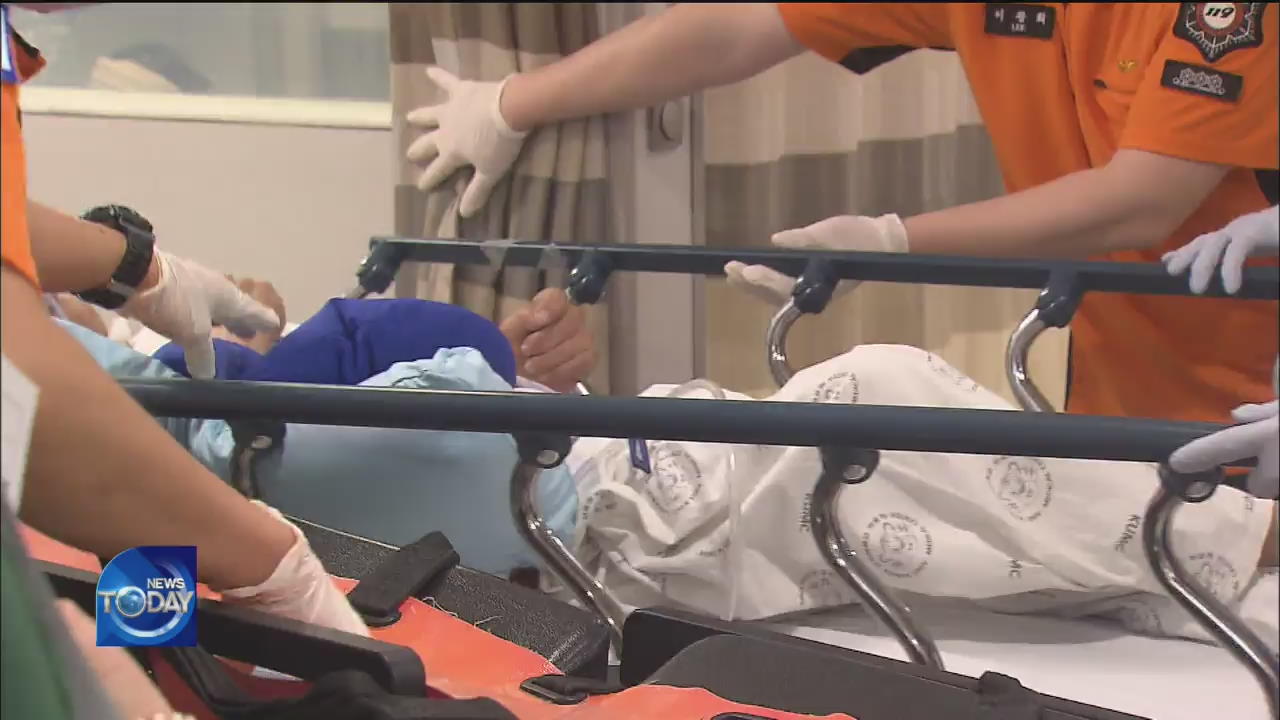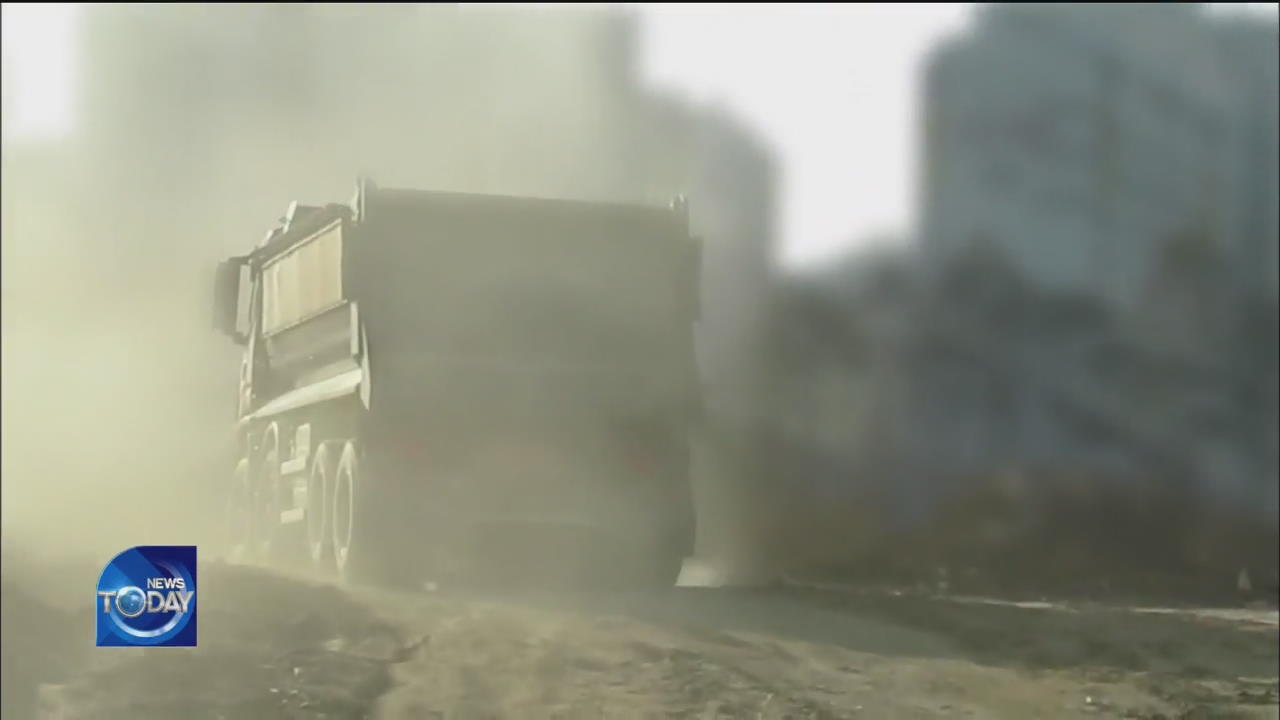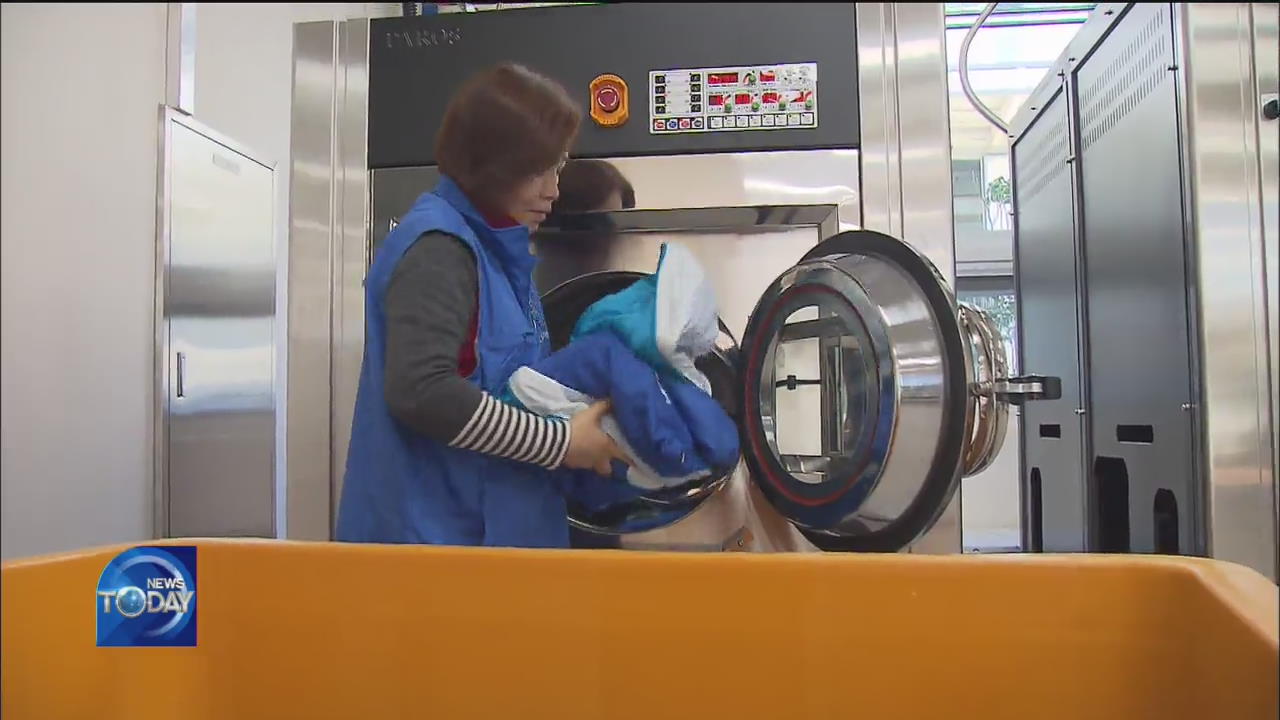DEATHS DURING MEDICAL TRANSPORTATION
입력 2019.10.22 (15:05)
수정 2019.10.22 (16:47)
읽어주기 기능은 크롬기반의
브라우저에서만 사용하실 수 있습니다.
[Anchor Lead]
An average of 2.5 emergency patients are known to die every day in the country while on their way to the hospital. This is because the patients failed to receive medical treatment within the so-called golden time window. The situation is far worse in the rural provinces where medical infrastructure is severely lacking.
[Pkg]
An elderly heart attack patient is being transported to the ER on a helicopter. Patients with such conditions or serious external injuries sustained from car accidents need to be carried to the hospital right away. To save lives, it's imperative that doctors treat them within a crucial window of time. For serious external injuries there's only about an hour long window while sudden heart attacks require medical attention within 2 hours. From January to August, 617 such emergency patients did not make it to the hospital and died on the way. This equals an average of 2.5 cases a day. About half of all cities, counties and districts nationwide failed to bring the patient in within that golden time. But there was huge disparity by region. In the rest of the country except for the capital area and other metropolitan cities, 70% of patients of serious injuries and 80% of heart attack cases failed to reach the hospital in time.
[Soundbite] PROF. CHUNG SUNG-PIL(GANGNAM SEVERANCE HOSPITAL) : "In these provinces, reaching the hospital often takes longer and it's also difficult to fully address the emergency situation with local resources."
Ulleung-gun County in Gyeongsangbuk-do Province was the slowest to respond, taking an average of 7 hours to transport patients to the ER. Among inland regions, the county of Goheung-gun in Jeollanamdo Province reported the longest response time of over 3 hours.
[Soundbite] REP. KIM KWANG-SOO(NAT'L ASSEMBLY HEALTH & WELFARE COMMITTEE) : "The Health Ministry should expand medical infrastructure in the provinces through measures like establishing a patient transport system and increasing emergency rooms."
The number of patients who died but could have survived if treated in a timely fashion was three times higher in the provinces than in Seoul.
An average of 2.5 emergency patients are known to die every day in the country while on their way to the hospital. This is because the patients failed to receive medical treatment within the so-called golden time window. The situation is far worse in the rural provinces where medical infrastructure is severely lacking.
[Pkg]
An elderly heart attack patient is being transported to the ER on a helicopter. Patients with such conditions or serious external injuries sustained from car accidents need to be carried to the hospital right away. To save lives, it's imperative that doctors treat them within a crucial window of time. For serious external injuries there's only about an hour long window while sudden heart attacks require medical attention within 2 hours. From January to August, 617 such emergency patients did not make it to the hospital and died on the way. This equals an average of 2.5 cases a day. About half of all cities, counties and districts nationwide failed to bring the patient in within that golden time. But there was huge disparity by region. In the rest of the country except for the capital area and other metropolitan cities, 70% of patients of serious injuries and 80% of heart attack cases failed to reach the hospital in time.
[Soundbite] PROF. CHUNG SUNG-PIL(GANGNAM SEVERANCE HOSPITAL) : "In these provinces, reaching the hospital often takes longer and it's also difficult to fully address the emergency situation with local resources."
Ulleung-gun County in Gyeongsangbuk-do Province was the slowest to respond, taking an average of 7 hours to transport patients to the ER. Among inland regions, the county of Goheung-gun in Jeollanamdo Province reported the longest response time of over 3 hours.
[Soundbite] REP. KIM KWANG-SOO(NAT'L ASSEMBLY HEALTH & WELFARE COMMITTEE) : "The Health Ministry should expand medical infrastructure in the provinces through measures like establishing a patient transport system and increasing emergency rooms."
The number of patients who died but could have survived if treated in a timely fashion was three times higher in the provinces than in Seoul.
■ 제보하기
▷ 카카오톡 : 'KBS제보' 검색, 채널 추가
▷ 전화 : 02-781-1234, 4444
▷ 이메일 : kbs1234@kbs.co.kr
▷ 유튜브, 네이버, 카카오에서도 KBS뉴스를 구독해주세요!
- DEATHS DURING MEDICAL TRANSPORTATION
-
- 입력 2019-10-22 15:03:36
- 수정2019-10-22 16:47:30

[Anchor Lead]
An average of 2.5 emergency patients are known to die every day in the country while on their way to the hospital. This is because the patients failed to receive medical treatment within the so-called golden time window. The situation is far worse in the rural provinces where medical infrastructure is severely lacking.
[Pkg]
An elderly heart attack patient is being transported to the ER on a helicopter. Patients with such conditions or serious external injuries sustained from car accidents need to be carried to the hospital right away. To save lives, it's imperative that doctors treat them within a crucial window of time. For serious external injuries there's only about an hour long window while sudden heart attacks require medical attention within 2 hours. From January to August, 617 such emergency patients did not make it to the hospital and died on the way. This equals an average of 2.5 cases a day. About half of all cities, counties and districts nationwide failed to bring the patient in within that golden time. But there was huge disparity by region. In the rest of the country except for the capital area and other metropolitan cities, 70% of patients of serious injuries and 80% of heart attack cases failed to reach the hospital in time.
[Soundbite] PROF. CHUNG SUNG-PIL(GANGNAM SEVERANCE HOSPITAL) : "In these provinces, reaching the hospital often takes longer and it's also difficult to fully address the emergency situation with local resources."
Ulleung-gun County in Gyeongsangbuk-do Province was the slowest to respond, taking an average of 7 hours to transport patients to the ER. Among inland regions, the county of Goheung-gun in Jeollanamdo Province reported the longest response time of over 3 hours.
[Soundbite] REP. KIM KWANG-SOO(NAT'L ASSEMBLY HEALTH & WELFARE COMMITTEE) : "The Health Ministry should expand medical infrastructure in the provinces through measures like establishing a patient transport system and increasing emergency rooms."
The number of patients who died but could have survived if treated in a timely fashion was three times higher in the provinces than in Seoul.
An average of 2.5 emergency patients are known to die every day in the country while on their way to the hospital. This is because the patients failed to receive medical treatment within the so-called golden time window. The situation is far worse in the rural provinces where medical infrastructure is severely lacking.
[Pkg]
An elderly heart attack patient is being transported to the ER on a helicopter. Patients with such conditions or serious external injuries sustained from car accidents need to be carried to the hospital right away. To save lives, it's imperative that doctors treat them within a crucial window of time. For serious external injuries there's only about an hour long window while sudden heart attacks require medical attention within 2 hours. From January to August, 617 such emergency patients did not make it to the hospital and died on the way. This equals an average of 2.5 cases a day. About half of all cities, counties and districts nationwide failed to bring the patient in within that golden time. But there was huge disparity by region. In the rest of the country except for the capital area and other metropolitan cities, 70% of patients of serious injuries and 80% of heart attack cases failed to reach the hospital in time.
[Soundbite] PROF. CHUNG SUNG-PIL(GANGNAM SEVERANCE HOSPITAL) : "In these provinces, reaching the hospital often takes longer and it's also difficult to fully address the emergency situation with local resources."
Ulleung-gun County in Gyeongsangbuk-do Province was the slowest to respond, taking an average of 7 hours to transport patients to the ER. Among inland regions, the county of Goheung-gun in Jeollanamdo Province reported the longest response time of over 3 hours.
[Soundbite] REP. KIM KWANG-SOO(NAT'L ASSEMBLY HEALTH & WELFARE COMMITTEE) : "The Health Ministry should expand medical infrastructure in the provinces through measures like establishing a patient transport system and increasing emergency rooms."
The number of patients who died but could have survived if treated in a timely fashion was three times higher in the provinces than in Seoul.
이 기사가 좋으셨다면
-
좋아요
0
-
응원해요
0
-
후속 원해요
0












![[속보] 내란특검 “윤 변호인 수사방해 의혹, <br>파견경찰이 자료수집 중”](/data/news/2025/07/04/20250704_zxJ5qZ.jpg)
![[속보] 추경안, 국회 예결소위 <br>통과…민주당 단독 처리](/data/layer/904/2025/07/20250704_YazNaR.jpg)



이 기사에 대한 의견을 남겨주세요.